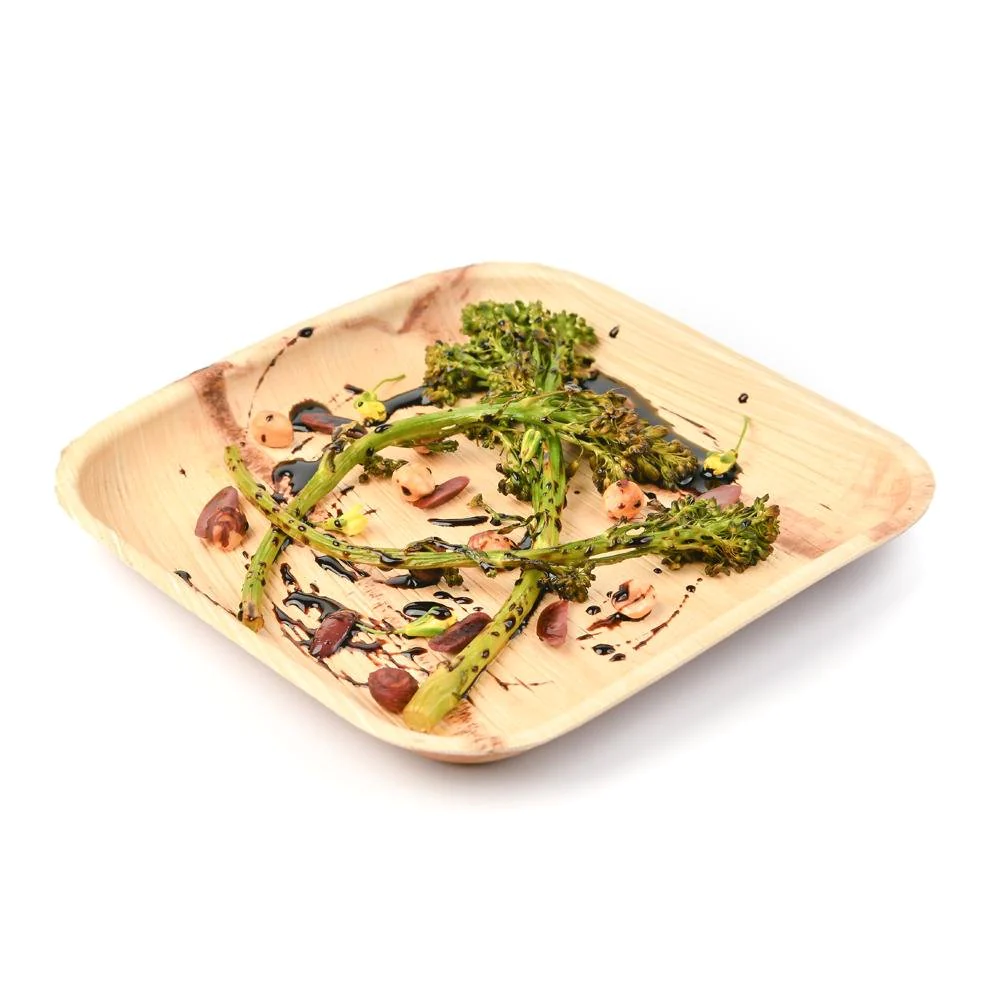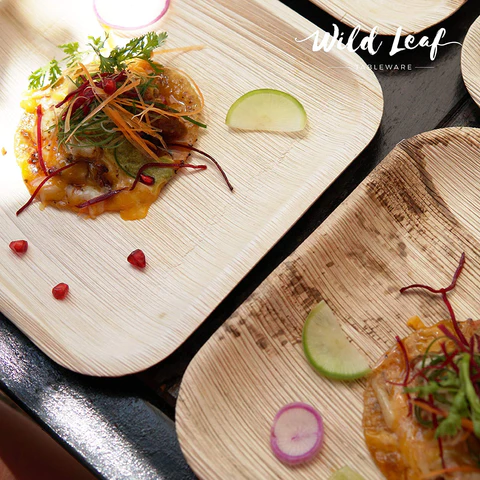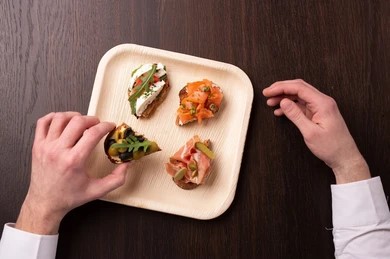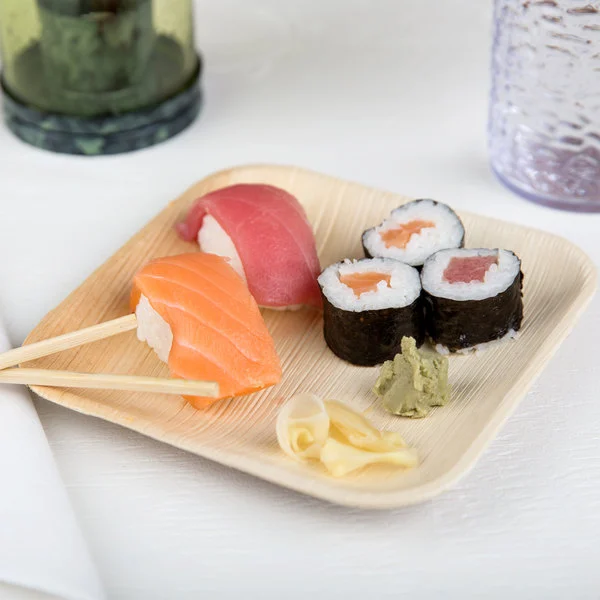Discover the eco-friendly and healthy dining alternative with Palm Leaf Plates. Perfect for reducing your carbon footprint and ensuring chemical-free meals, they are the sustainable choice for a greener future. Learn why Palm Leaf Plates are the best for both health and the environment.
Introduction to Sustainable Living
In an era where the echo of sustainability reverberates louder each day, making eco-friendly choices has become more than just a trend—it’s a necessity. Among these green choices, palm leaf plates stand out as a beacon of health and environmental sustainability. This article delves into why they are an optimal choice for both.
Table of Contents
The Environmental Benefits of Palm Leaf Plates
1. Biodegradability and Compostability
One of the most compelling environmental benefits of palm leaf plates is their complete biodegradability and compostability. Unlike plastic or Styrofoam plates, which can take hundreds of years to decompose and often leave microplastics in the environment, palm leaf plates break down naturally within a few months when composted. This means they return to the earth without harming the environment, contributing to a healthier, more sustainable planet.
2. Sustainable Resource Use
Palm leaf plates are made from naturally fallen leaves that would otherwise decompose and go to waste. This sustainable resource use ensures that no trees are cut down in the production process, preserving the natural ecosystem and biodiversity. It also means that the production of palm leaf plates has a much lower environmental impact compared to other disposables that require the harvesting of raw materials, such as wood for paper plates or petroleum for plastic ones.
3. Reduction in Carbon Footprint
The production and disposal of traditional disposable tableware contribute significantly to carbon emissions. In contrast, the manufacturing process for palm leaf plates is energy-efficient and has a much lower carbon footprint. Since it primarily involves collecting, cleaning, and pressing the leaves into shape, the process consumes far less energy and emits fewer greenhouse gases. Moreover, as a plant-based product, the growth of Areca palms absorbs CO2 from the atmosphere, further offsetting the carbon footprint of these plates.
4. Non-Toxic and Chemical-Free
Palm leaf plates are produced without the use of chemicals or synthetic additives, making them a non-toxic choice for consumers. In comparison, many plastic products can release harmful chemicals into food, especially when heated. By choosing palm leaf plates, consumers can avoid exposing themselves and the environment to potentially hazardous substances.
5. Promotes Waste Reduction
The disposable nature of palm leaf plates might seem counterintuitive to waste reduction, but when compared to washing traditional tableware, the water and energy savings can be significant, especially for large events. Additionally, because they are compostable, they can be disposed of with organic waste, contributing to the production of nutrient-rich compost instead of ending up in landfills.
6. Encourages Sustainable Practices
The popularity of palm leaf plates can encourage more sustainable practices in the disposables industry. As demand for eco-friendly products increases, it can drive innovation and the development of more sustainable materials and production method

Health Advantages of Using Palm Leaf Plates
1. Chemical-Free Manufacturing
Palm leaf plates are produced without the use of chemicals, plastics, or synthetic additives, making them a safer choice for serving food. The manufacturing process is simple and natural: the leaves are collected, washed with water, and then pressed into shape using heat. This means there’s no risk of harmful substances leaching into your food, a concern often associated with plastic tableware, especially under heat.
2. Non-Toxic and Safe for Consumption
The absence of chemicals in the production process ensures that palm leaf plates are non-toxic and safe for consumption. Unlike plastic or Styrofoam products that can release hazardous chemicals like BPA, phthalates, or styrene into food, particularly when heated, palm leaf plates maintain their natural integrity under various temperature conditions. This makes them an ideal choice for serving both hot and cold foods.
3. Allergy-Friendly
For individuals with sensitivities or allergies to certain chemicals commonly found in plastics and other synthetic materials, palm leaf plates offer a worry-free alternative. Since they are made from a natural, single ingredient without any additives, the risk of allergic reactions is significantly reduced, making meal times safer and more enjoyable for everyone, especially those with heightened sensitivities.
4. Promotes Healthy Eating
The use of natural materials like palm leaves in tableware can also encourage a more health-conscious approach to eating. Knowing that your food is served on eco-friendly, chemical-free plates can enhance the overall dining experience, making it not only more enjoyable but also aligned with a healthy, sustainable lifestyle. This psychological aspect of consuming food from a natural source can motivate individuals to make healthier food choices, aligning with a holistic approach to health and well-being.
5. Biodegradable and Compostable
While not a direct health benefit, the biodegradability and compostability of palm leaf plates contribute to a healthier environment, which in turn supports public health. Reducing pollution and waste, and minimizing chemical exposure in the environment, leads to cleaner air, water, and soil, ultimately benefiting the health of communities and ecosystems.
6. Sustainable and Renewable Resource
The use of a sustainable and renewable resource like fallen palm leaves for making plates ensures that there is no depletion of natural resources or adverse environmental impact associated with their production. This sustainable practice supports the health of the planet, which is intrinsically linked to the health of its inhabitants. By choosing palm leaf plates, consumers contribute to a cycle of sustainability that promotes the well-being of the earth and its people.

Economic and Social Impact
Supporting Local Economies
The production of palm leaf plates often relies on the labor and skills of local artisans and workers in rural areas where palm trees grow. This industry creates employment opportunities in regions that might otherwise have limited job prospects. By providing a source of income for these communities, the palm leaf plate industry helps to uplift local economies and reduce poverty levels. The demand for these eco-friendly products can lead to the establishment of small to medium enterprises (SMEs), fostering economic growth and development in underprivileged areas.
Sustainable Agricultural Practices
Palm leaf plates are made from the fallen leaves of the Areca palm tree, which means their production encourages sustainable agricultural practices. Unlike other crops that might require intensive farming techniques, the Areca palm trees do not need to be cut down to harvest the leaves. This sustainable harvesting ensures that the natural ecosystem is preserved, and the biodiversity of the area is maintained. Farmers can benefit from a continuous source of income without resorting to deforestation or other harmful agricultural practices.
Empowering Communities
The palm leaf plate industry can play a crucial role in empowering local communities, especially in empowering women who often make up a significant portion of the workforce in this sector. By providing fair wages and fostering a sense of community involvement, the industry can contribute to improved living standards and greater economic independence for individuals and families. This empowerment leads to positive social change, including better access to education and healthcare within these communities.
Encouraging Sustainable Consumerism
The rising popularity of palm leaf plates also has a broader social impact by encouraging sustainable consumerism. As consumers become more aware of the environmental and social benefits of choosing eco-friendly products, there is a growing demand for goods that are not only good for the planet but also support ethical business practices. This shift in consumer behavior can drive more companies to adopt sustainable and socially responsible practices, leading to a positive impact on global economic and social structures.

Cultural Preservation
In some regions, the traditional knowledge and techniques used in the production of palm leaf plates are an integral part of the cultural heritage. By sustaining the demand for these products, we help preserve these cultural practices and ensure they are passed down to future generations. This aspect of the palm leaf plate industry highlights the importance of protecting not only the environment but also the cultural identities and heritage of communities involved in their production.
Comparison with Other Disposable Plates
Palm Leaf vs. Plastic Plates
Environmental Impact: Plastic plates are made from petroleum, a non-renewable resource, and their production releases significant amounts of CO2 into the atmosphere. They are not biodegradable, taking hundreds of years to break down, and often end up in landfills or oceans, contributing to pollution and harm to wildlife. In contrast, palm leaf plates are made from naturally fallen leaves, are completely biodegradable, and compost within a few months, significantly reducing their environmental footprint.
Health Considerations: Plastic plates can release harmful chemicals, especially when used with hot foods. These chemicals can include BPA and phthalates, which have been linked to health issues ranging from hormonal disruptions to increased cancer risk. Palm leaf plates, however, are free from chemicals and safe for use with all types of food, providing a healthier option for consumers.
Sustainability: The use of plastic plates contributes to the depletion of fossil fuels and adds to the problem of plastic pollution. Palm leaf plates, being a product of natural and renewable resources, promote a sustainable cycle of use without depleting the earth’s resources.
Palm Leaf vs. Paper Plates
Environmental Impact: While paper plates are often touted as a more eco-friendly option than plastic because they are biodegradable, their production is resource-intensive. It requires large amounts of water, chemicals for bleaching and processing, and wood from trees. This can lead to deforestation and a higher water footprint. Palm leaf plates, on the other hand, utilize fallen leaves that would otherwise go to waste, making them a more environmentally friendly option.
Energy Consumption: The production of paper plates requires significant energy, primarily due to the processes of pulping and drying. Palm leaf plates require much less energy to produce, as their manufacturing process involves simply collecting, cleaning, pressing, and sterilizing the leaves.
Compostability: Both paper and palm leaf plates are compostable, but palm leaf plates compost more quickly and without leaving any toxic residue. Some paper plates are coated with plastic or wax to make them waterproof, which complicates their composting process and can introduce pollutants into the compost.
Economic and Social Benefits
Beyond environmental and health comparisons, palm leaf plates also offer economic and social benefits, particularly in rural areas where they are produced. They provide employment opportunities and support sustainable agriculture practices, aspects that are not directly associated with the production of plastic or paper plates.

How to Integrate Palm Leaf Plates into Everyday Life
1. Daily Meals
Switching to palm leaf plates for daily meals can significantly reduce your household’s environmental impact. Use them for casual dining, outdoor meals, or whenever you prefer a quick cleanup without resorting to plastic. Their natural and unique patterns add an earthy charm to your dining table, making everyday meals feel special.
2. Parties and Gatherings
Palm leaf plates are perfect for birthday parties, family gatherings, barbecues, and any event where you might otherwise use disposable tableware. They offer a stylish and eco-friendly alternative to conventional disposables, and guests will appreciate the sustainable choice. Plus, their sturdy construction can handle a variety of foods, from hot dishes to cold desserts.
3. Picnics and Outdoor Adventures
For picnics, camping trips, and beach outings, palm leaf plates are an excellent choice. They are lightweight, easy to pack, and won’t harm the environment if you choose to dispose of them. Since they’re compostable, they align with the leave-no-trace principles important to outdoor enthusiasts.
4. Special Occasions and Celebrations
Weddings, anniversaries, and special celebrations can benefit from the elegant and rustic appeal of palm leaf plates. They can elevate the event’s aesthetic while showcasing a commitment to sustainability. Many caterers and event planners now offer palm leaf tableware options to meet the growing demand for eco-friendly alternatives.
5. Gifts and Party Favors
Palm leaf plate sets make thoughtful gifts for environmentally conscious friends and family members. They’re also unique party favors for guests at eco-friendly weddings or events, serving as a practical reminder of the importance of sustainable living.
6. Craft Projects
Unused or lightly used palm leaf plates can be repurposed for various craft projects, especially with children. Their natural texture and shape provide a unique canvas for painting, decoupage, or other creative endeavors, making them a versatile material for eco-conscious art projects.
7. Educational Opportunities
Using palm leaf plates can be a conversation starter about sustainability and environmental responsibility. They offer a tangible way to educate family members, especially children, about the importance of making eco-friendly choices in our daily lives.
8. Supporting Eco-Friendly Businesses
By choosing palm leaf plates, you’re supporting businesses that prioritize sustainability. Look for companies that source their products ethically and contribute to environmental conservation efforts. Your purchase can help promote a market for sustainable goods, encouraging more businesses to adopt eco-friendly practices.

Challenges and Considerations
1. Availability and Accessibility
Palm leaf plates may not be as readily available in all markets or regions as traditional disposable tableware. Consumers in areas without access to eco-friendly stores or online shopping platforms that offer such products might find it difficult to purchase palm leaf plates. This limitation can hinder the widespread adoption of these sustainable alternatives.
2. Cost Implications
Initially, palm leaf plates can be more expensive than plastic or paper plates due to the processes involved in their production and distribution. For individuals, families, or businesses operating on tight budgets, the higher cost might be a significant barrier to switching to palm leaf plates for everyday use or events.
3. Consumer Awareness and Perception
There is still a considerable lack of awareness about the benefits of palm leaf plates and other eco-friendly alternatives. Some consumers may perceive them as less convenient or aesthetically pleasing compared to traditional options. Overcoming these perceptions and educating the public about the environmental and health advantages of palm leaf plates is essential for increasing their acceptance and use.
4. Cultural and Behavioral Changes
Adopting palm leaf plates requires a shift in consumer behavior and cultural norms, especially in societies accustomed to using plastic disposables for convenience. Encouraging people to choose eco-friendly options involves changing long-standing habits and preferences, which can be a slow and challenging process.
5. Quality and Performance Variability
The natural origin of palm leaf plates means that they can vary in thickness, size, and shape. While many appreciate this uniqueness, others might prefer the uniformity offered by conventional disposable plates. Additionally, questions about the suitability of palm leaf plates for holding very hot or liquid foods might arise, although they are generally quite sturdy and heat resistant.
6. Disposal and Composting Facilities
Although palm leaf plates are compostable, the effectiveness of this process depends on the availability of proper composting facilities. In areas without such facilities, the environmental benefits of using biodegradable plates are less impactful. Encouraging the development and use of community or home composting systems can help maximize the environmental advantages of palm leaf plates.
7. Regulatory and Policy Support
The broader adoption of sustainable products like palm leaf plates could benefit from stronger regulatory and policy support. Incentives for businesses to produce and sell eco-friendly products, alongside policies that discourage the use of non-biodegradable disposables, can play a significant role in overcoming some of the challenges associated with switching to palm leaf plates.
The Future of Sustainable Dining
1. Innovations in Eco-Friendly Tableware
The development of sustainable tableware is rapidly advancing, with palm leaf plates being just one example among many innovative solutions. Researchers and companies are exploring new materials, such as edible cutlery, biodegradable composites made from agricultural waste, and dishes created from seaweed or other plant-based substances. These innovations aim to reduce waste and lower the carbon footprint associated with dining, promising a future where sustainable tableware is the norm rather than the exception.
2. Zero-Waste Restaurants and Cafes
The concept of zero-waste dining is gaining traction, with more restaurants and cafes aiming to eliminate food waste and minimize their environmental impact. These establishments focus on using every part of the ingredients, composting organic waste, and avoiding single-use packaging. The zero-waste movement not only promotes sustainability within the food industry but also inspires consumers to adopt similar practices in their own lives.
3. Plant-Based Menus
The rise of plant-based diets is another significant trend contributing to the future of sustainable dining. As more people opt for vegetarian or vegan meals due to health, ethical, or environmental reasons, restaurants and food services are expanding their plant-based offerings. This shift is expected to continue growing, reducing reliance on animal agriculture, which is a major source of greenhouse gas emissions and environmental degradation.
4. Local and Seasonal Food Sourcing
There is an increasing emphasis on sourcing food locally and seasonally, reducing the carbon footprint associated with transporting ingredients over long distances. This practice supports local farmers and communities, promotes biodiversity, and ensures fresher, more nutritious meals. Restaurants and consumers alike are recognizing the value of connecting with local food systems for both sustainability and quality.
5. Digital Platforms for Food Sharing and Waste Reduction
Technology plays a crucial role in the future of sustainable dining, with apps and digital platforms designed to reduce food waste. These platforms allow restaurants, cafes, and even individuals to share or sell surplus food, preventing it from going to waste and providing meals to those in need. This approach not only tackles food waste but also addresses food insecurity, making sustainable dining accessible to a wider audience.
6. Sustainability Education and Awareness
Education and awareness efforts are key to advancing sustainable dining practices. Cooking classes, workshops, and informational campaigns that focus on sustainable cooking techniques, waste reduction, and the environmental impact of food choices can empower individuals to make more eco-friendly decisions. As knowledge spreads, sustainable dining practices are likely to become ingrained in societal norms.

Conclusion
Palm leaf plates represent a harmonious blend of tradition, innovation, and sustainability. By choosing them, we contribute to a healthier planet and a safer dining experience, making them the green choice for our health and the environment.
FAQs
- Are palm leaf plates safe for hot foods? Yes, they are heat resistant and can safely hold hot foods.
- How long do palm leaf plates take to compost? They typically compost within 2-6 months in a proper composting setup.
- Can palm leaf plates be reused? While designed for single use, they can be gently washed and reused for dry or non-greasy foods.
- Are palm leaf plates more expensive than plastic plates? Initially, they may be more costly, but considering their environmental benefits, they offer greater value in the long term.
- Where can I purchase palm leaf plates? They are available online, in eco-friendly stores, and in some supermarkets.

